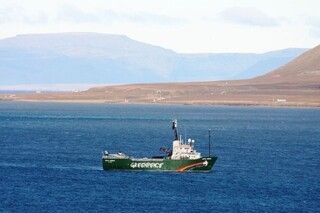Free the Arctic 30
Caspar Henderson
On 10 July 1985 a limpet mine attached to the Greenpeace ship Rainbow Warrior exploded, tearing a hole the size of a car in its hull. The ship, which was docked in Auckland harbour, began to list. Captain Peter Wilcox and his crew of twelve disembarked. After a few minutes, with all quiet and the ship having settled but not sunk, the photographer Fernando Pereira went back on board to retrieve equipment. A second bomb exploded, sending the ship to the bottom and drowning him.
The French government saw Greenpeace protests against its nuclear weapons tests in the Pacific as a threat to its national interests and had ordered its agents to plant the bombs. They had not intended to kill anyone – they had assumed that the crew would remain onshore after they first bomb – but they had certainly meant to intimidate.
Intimidation must have been part of the plan when, on 18 September this year, Russian coastguards descended from helicopters onto the Greenpeace ship Arctic Sunrise and seized everyone on board – Captain Wilcox, 27 other activists from 18 countries, including Dimitri Litvinov, a descendant of Stalin's foreign minister but a Swedish and American citizen, and two journalists – at knife and gunpoint. Protesters from the ship had previously tried to board the Prirazlomnaya oil platform in the Pechora Sea between the Novaya Zemlya archipelago and the Russian mainland.
The Arctic Sunrise was towed to Murmansk. All 30 people were detained and, on 27 September, charged with piracy, which carries a 15 year sentence under Russian law. On 23 October the charges were changed to aggravated hooliganism, which carries a maximum sentence of seven years. The activists have so far been held for 51 days.
Russian state media say that the Greenpeace ‘eco-blackmailers’ are financed by the US State Department and that their battle is not merely with Gazprom, the owner and operator of the rig, but with Russia itself. Polling data reportedly show that 60 per cent of Russians approve of the government’s action, and 8 per cent consider it too lenient. Eleven Nobel peace laureates called on Vladimir Putin to drop the piracy charges. The chief executive of the Italian oil firm Eni, Gazprom's biggest client, and the Iranian vice president, Masoumeh Ebtekar, to release the activists. The government of the Netherlands, where the Arctic Sunrise is registered, says that the boarding of the ship breaches the UN Convention on the Law of the Sea (UNCLOS) and customary international law, and has asked the International Tribunal for the Law of the Sea to order Russia to release the ship and the activists. But the Russian government does not acknowledge UNCLOS settlement procedures.
Russia is the world's largest exporter of oil and gas. Gazprom, which is 50.01 per cent owned by the state, accounts for 16 per cent of global gas production. The Russian government has asserted sovereign rights to the seabed all the way to the North Pole. The Prirazlomnaya platform is an Arctic-class ice-resistant facility, the first of its kind. The Russian government says it is investing more than $63 billion by 2020 to discover and exploit new reserves in the Arctic.
Greenpeace says its protests are intended to draw attention to the risk of pollution in fragile Arctic environments and to call time on the exploitation of new reserves of fossil fuels. There is already enough coal, oil and gas exploitable at lower latitudes to cause dangerous climate change. The activists' position may seem sentimental or misguided when you look down the barrel of realpolitik. Europe's largest economies will be dependent on Russian gas until they can develop reliable alternatives; their muted response to the case is hardly surprising. But things can change. The French government was severely embarrassed by the Rainbow Warrior case and eventually stopped its nuclear tests in the Pacific.
